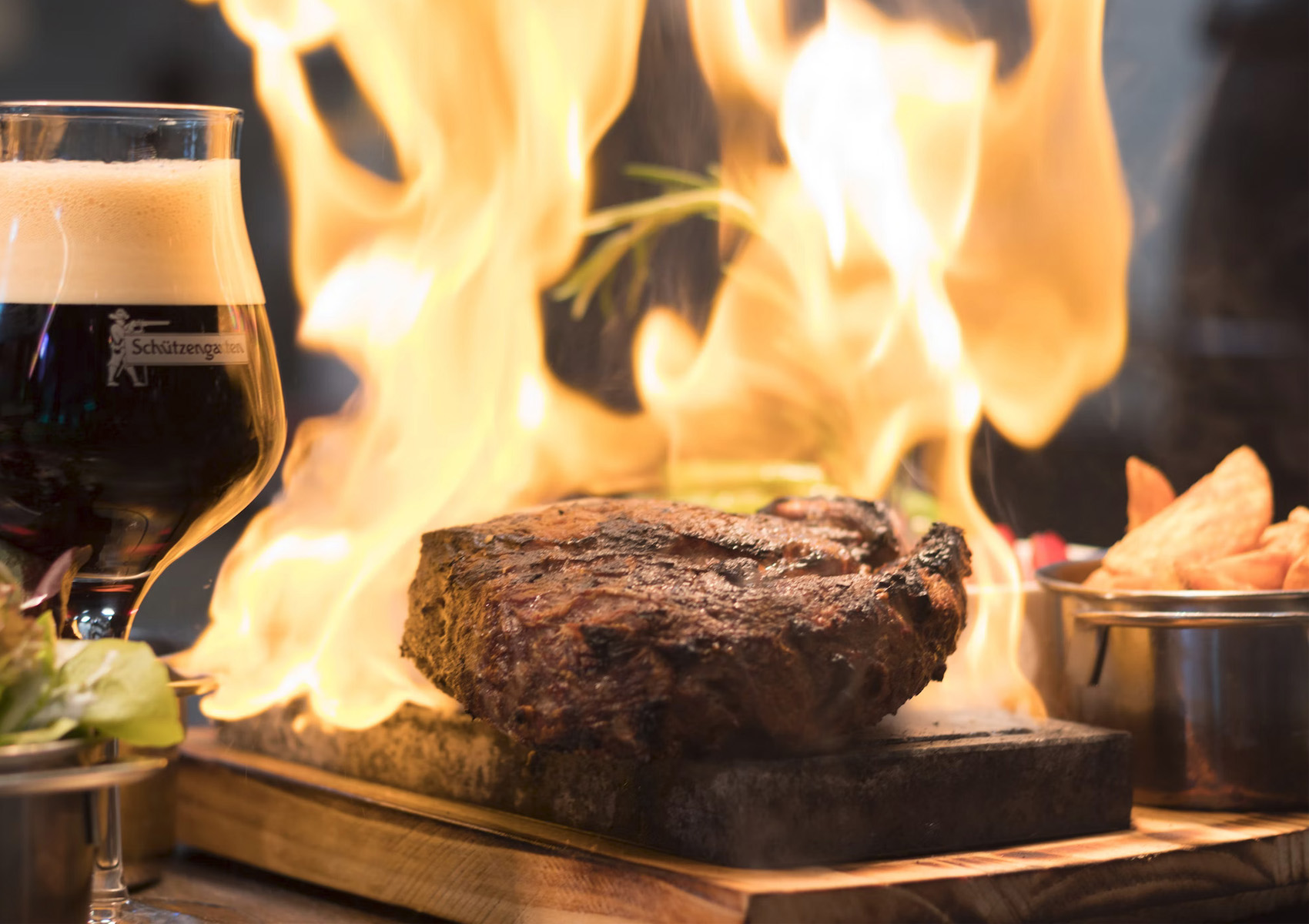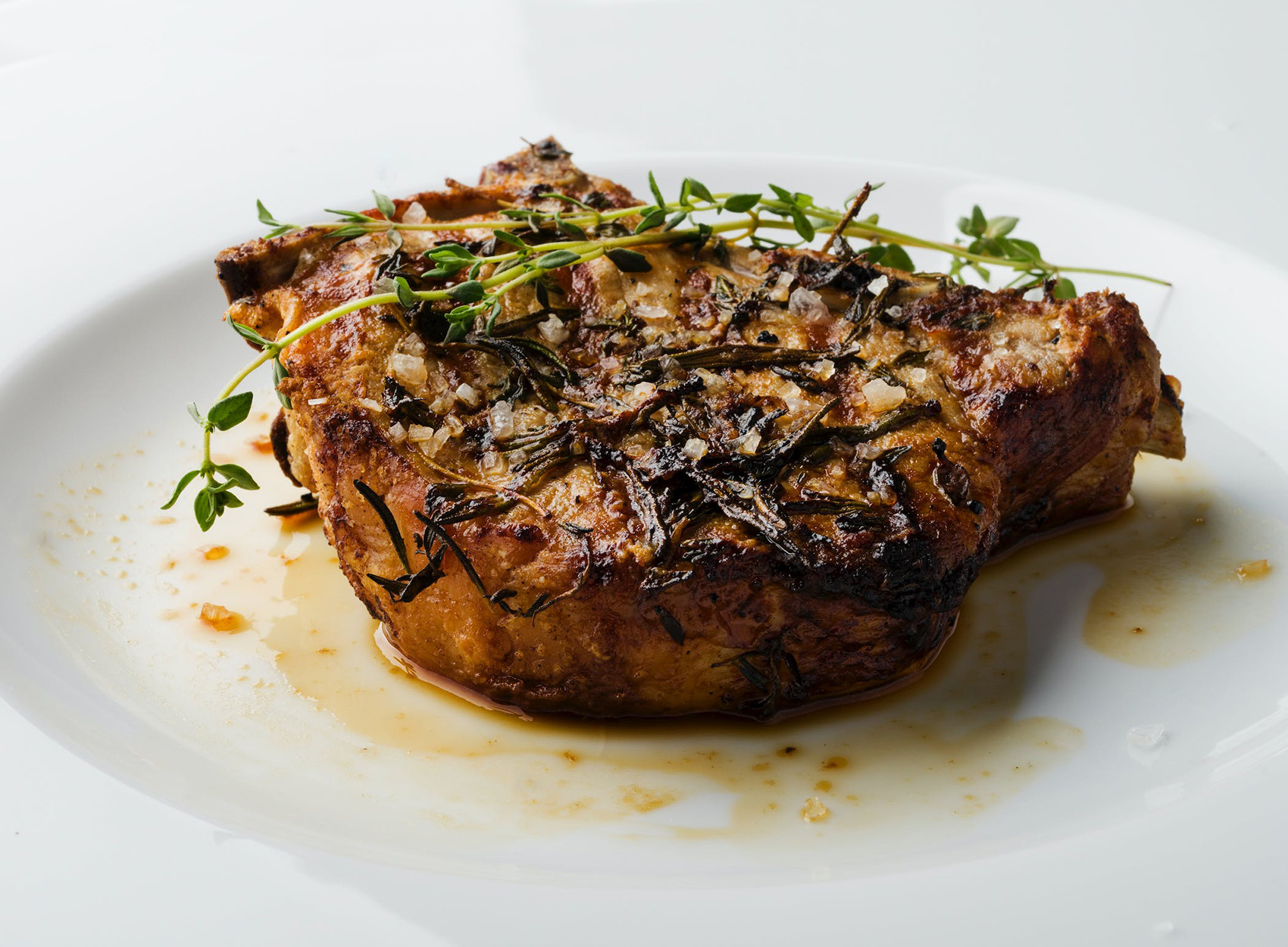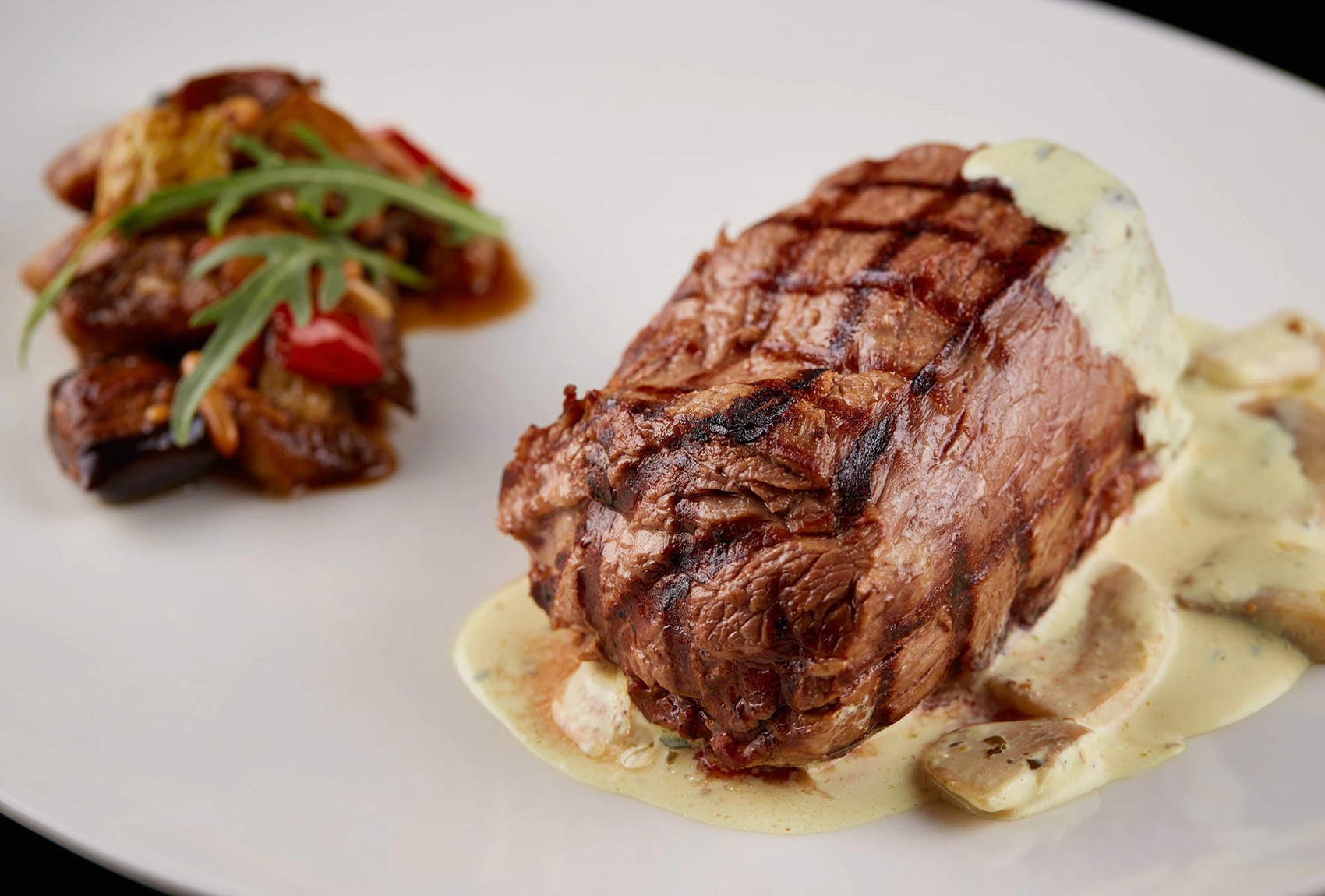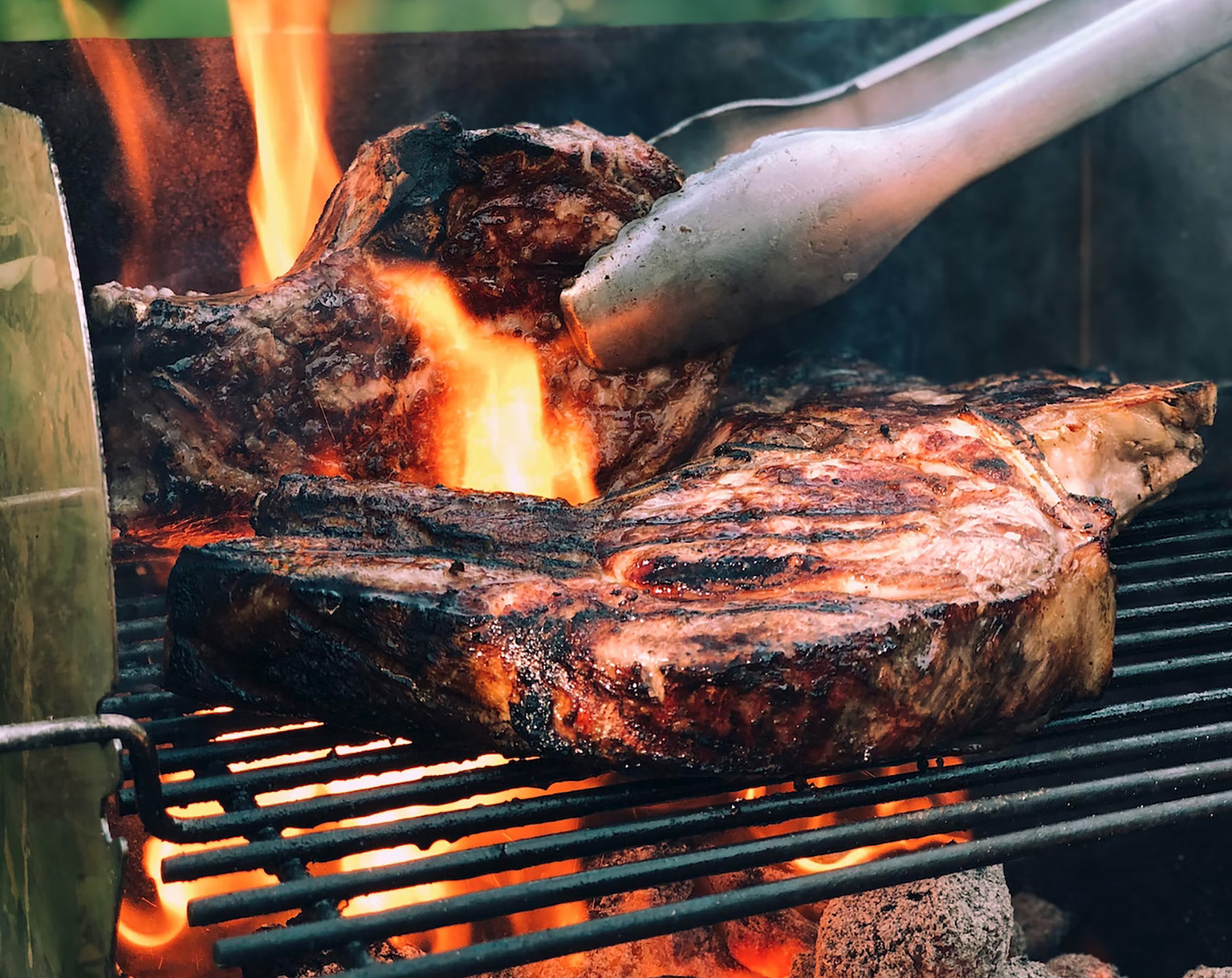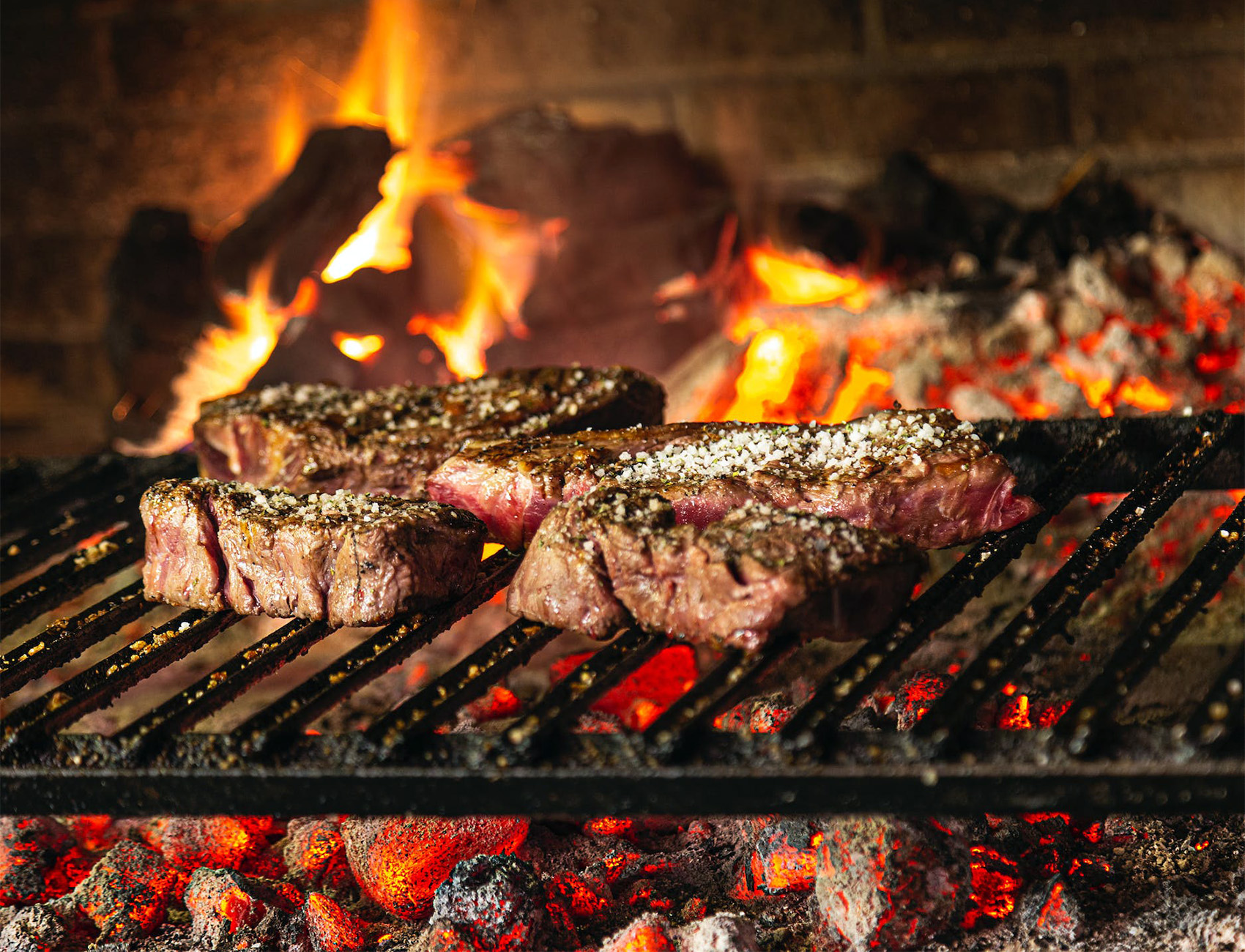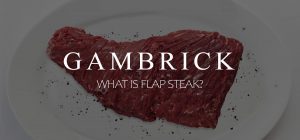T-Bone Vs Ribeye Steak
T-Bone and Ribeye steaks are two of the highest quality cuts of beef you can buy. They’re both tender, juicy, fairly lean and very flavorful steaks with a lot in common. However there are some key difference to consider before choosing which to order. T-Bone steaks are cut from the cow’s short loin and include a T-shaped bone with meat on both sides. Ribeye steaks are cut from the cow’s upper rib cage close to the neck and are served either bone-in or boneless. T-Bone steaks are typically thinner and range from 0.5 to 2 inches, while a Ribeye is usually 2 inches thick or more. In terms of price, T-Bones tend to be a little bit cheaper than Ribeye but are just as tender, juicy and flavorful.
A T-Bone is actually two steaks in one (New York Strip and Tenderloin) separated by a T-shaped bone. Ribeye is a single oval-shaped cut, usually thicker and fatter than a T-Bone. But Ribeye is available in either bone-in or boneless versions. Unlike a T-Bone, a bone-in Ribeye’s bone is off to the side and not running through the meat.
Ribeye steak has more calories than T-Bone steak because of its extra fat content. 100 grams of Ribeye steak contains 271 calories. In contrast, 100 grams of T-Bone steak has 247 calories which is about 18% less than Ribeye steak.
Both steaks are commonly served in steakhouses around the world because of their great taste and tenderness. You can find them in steak dishes, but they’re most commonly served as a traditional steak dinner seasoned with salt and pepper. But you can get both steaks at a butcher or your local grocery store and cook them at home.
Ribeye Vs T-bone Steaks: Which Is Better?
Overall I think a boneless Ribeye steak is the better choice. But they’re both excellent, extremely high grade steaks with great flavor, texture and tenderness. Honestly, you can’t go wrong with either cut but I prefer my steaks boneless.
- Marbling: If you like a steak with fat marbling then you’ll prefer a Ribeye to a T-Bone. But because of its higher fat content Ribeye steaks are also higher in calories. 100 grams of Ribeye steak contains 271 calories. while 100 grams of T-Bone steak has just 247 calories. That’s about 18% more than a T-Bone.
- Thickness: If you like a thick steak you’ll prefer a Ribeye. On average, Ribeye steaks are about 2 inches thick, while T-Bones range from 0.5 to 2 inches, most measuring around 1.5 inches.
- Healthy: Both steaks contain about the exact same nutritional value per 100 grams, but T-Bones have less calories which may be considered a bit healthier. However keep in mind how you cook the meat has a big impact on its cooked calorie vs raw calorie content.
- Flavor: Both T-Bone and Ribeye are very flavorful steaks. Boneless Ribeyes have a milder beef flavor compared to bone-in Ribeyes and T-Bones because of the bones. Steak bones are packed with marrow and flavor if you pan cook the meat. If you want a strong beef flavor, choose the bone-in Ribeye or T-Bone.
- Cooking: Ribeye steak usually take longer to cook because they’re thicker. However, marbled steaks cook faster, so when comparing a Ribeye and T-Bone of equal thickness, the Ribeye actually cooks faster. T-Bone and bone-in Ribeye tend to cook slower because the bone absorbs heat which makes the meat around it cook slower.
- Price: Ribeye is more expensive than T-Bone by 20% to 40% on average.
Differences Between T-Bone & Ribeye
T-Bone and Ribeye steaks are very similar in terms of taste, texture, flavor and tenderness, but they’re cut from different sections of the cow which gives them a few key differences. Ribeye has more marbling and a higher fat content than T-Bone but it has fewer large strips of fat. T-Bone has a richer beef flavor because of the bone and is actually two steaks in one, a NY Strip and a Filet.
Choosing the best cut of meat for your nest steak dinner depends on a few factors which we’ll outline in the table below and then discuss in detail throughout the article.
| T-Bone | Ribeye | |
|---|---|---|
| Taste | Strong beef flavor due to the bone | Rich buttery flavor due to its marbling |
| Bone |
Bone-In | Bone-In or Boneless |
| Price | Expensive at $11 per pound for regular grocery store steak and $20+ per pound for grass fed. | More expensive at $16 per pound for regular grocery store steak and $30+ per pound for grass fed. |
| Marbling | Medium | Medium to high |
| Thickness | 0.5 to 2 inches. Steaks average 1.5 inches | 2 inches and up on average |
| Cut From | The short loin | The rib portion of the cow called the Prime Rib |
| Calories Per 100 Grams | 247 | 271 |
Main Differences Between T-Bone & Ribeye
Ribeye and T-Bone steaks are very similar in terms of quality, texture, tenderness, juiciness and flavor. However, there are still some big differences, the biggest of which being a T-Bone’s large T-shaped bone. A bone-in steak has a very different taste and fat content vs a bone-less steak. However, Ribeye steaks come bone-in or boneless, so the differences between the two steaks gets complicated based on which version of a Ribeye you’re evaluating.
The main differences between T-Bone & Ribeye steaks are:
- T-Bone steak is taken from the cow’s short loin, whereas Ribeye is taken from the prime rib section.
- T-bone has a large “T” shaped bone, whereas Ribeye typically comes without a bone. Although you can buy Ribeye bone-in.
- When a Ribeye is bone-in, the bone is along on side and not running through the meat like a T-Bone. This makes it easier to trim away.
- T-bone steaks are actually made up of two different steaks, a New York strip and a Tenderloin, whereas Ribeye is a single steak cut.
- Ribeye has a higher fat content because it’s well marbled, however T-Bones have larger strips of fat.
- Ribeye steaks are a bit more expensive.
- T-Bones steaks are thinner averaging 0.5 to 2 inches each, the average being 1.5 inches thick. Ribeye steaks average 2 inches.
T-Bone vs. Ribeye: Appearance & Size
T-Bone and Ribeye steaks look nothing alike. The T-bone is actually two steaks in one, a New York Strip and Tenderloin, separated by the distinctive T-shaped bone the steak is named after. Ribeye is a single oval-shaped steak with or without a bone. When there in a bone, it’s along one side of the steak and not through the meat like a T-Bone.
Ribeye steaks are usually thicker and fatter than a T-Bone averaging about 2 inches thick. T-Bones can get 2 inches thick but average 1.5 inch and range from 0.5 to 2 inches.
If a T-Bone steak has a tenderloin filet that’s larger than 1.5 inches wide it’s considered a Porterhouse, which is the main reason why T-Bones don’t get that large.
Most steakhouses will list both Ribeye and T-Bone steaks as a meal for either one or two diners depending on the size of the steak and what other sides you’re ordering with the meal.
In terms of fat content, Ribeye steaks have more marbling and have an overall higher fat content, which is why they also have more calories per 100 gram serving. But T-Bones tend to have larger chunks of fat, particularly around the bone.
What’s A Ribeye Steak?
Ribeye is a beef steak cut from the prime rib area of the cow in the upper rib cage. Which is why the steaks are also called Prime Rib Steaks. It’s cut from the back of the cow between the neck and the rump steak. The steak is considered rib meat which has a distinct beef flavor with lots of juice and good marbling. The meat stays juicy when grilled, cooked in the oven or pan fried and is quite tender.
- Ribeye steaks are cut from the cow’s upper rib cage close to the neck and are served either bone-in or boneless. This area of the cow is known as the prime rib.
- The rib section of the cow includes about six to twelve rib steaks along the longissimus dorsi muscle.
- Every Ribeye has a fatty rib bone running along one side which can be trimmed off to create a boneless steak or left on if you prefer a bone-in steak.
- A Ribeye get its name from its muscle strand that looks like an eye and the rib bone attached to it.
Ribeye steaks are know for their flavor, marbling and tenderness. They’re a premium grade steak served in world class steakhouses throughout the world.
Why Are Ribeye Steaks So Popular?
Ribeye steak is so popular because its one of the best cuts of beef you can eat. It’s very tender rib meat with great flavor, texture and juiciness. When cooked properly, a Ribeye will be tender enough to cut with a fork due to its high fat marbling which is a characteristic of most great steaks. The fat keeps the meat juicy and tender and gives it a bold beef flavor. But its not chewy like the large strips of fat found on cheaper cuts.
If you want a tender, juicy and flavorful steak that has good fat content while still being fairly lean, Ribeye is among the best. But it’s also one of the most expensive steaks you can buy per 100 gram serving.
What Does Ribeye Taste Like?
Ribeye steak comes in two versions, bone-in and boneless. Both have a fantastic beef flavor but different in how strong the flavor profile is. A Boneless Ribeye has a more subtle beef flavor while a bone-in Ribeye’s beef flavor is much stronger. This is amplified even more if you cook a bone-in Ribeye in a pan. The extra beef flavor comes from the marrow contained inside the bone.
Bone-in Ribeye tastes a lot more like a T-Bone because of the marrow. A boneless Ribeye has a more subtle flavor compared to a T-Bone.
If you cook a boneless or bone-in Ribeye in a pan, it will have a stronger beef flavor because of the marrow and/or marbling. If you grill it, the beef flavor will be more subtle but you may pick up some smokiness from the charcoal.
How To Cook Ribeye
The best way to cook a Ribeye is either on the grill or in a pan. It’s a fairly easy to steak cook because Ribeyes typically have a uniform thickness and great marbling without many large fat strips. However they come in two forms, boneless and bone-in. Any time you cook steak with a bone you have to be aware that meat around the bone cooks slower than large sections of meat. This is because the bone shields the meat and absorbs heat.
Ribeye is best when seared over extremely high, dry heat. This develops a wonderful golden crust on the outside and locks in juices which makes the meat even more tender and juicy.
Here are some tips on how to properly cook a Ribeye:
- Remove your steak from the packaging and pat it dry. Let it rest until it reaches room temperature.
- Get the grill or pan as hot as possible.
- Season your Ribeye with generous amounts of coarse salt and black pepper.
- Place the meat onto the searing hot grill or pan.
- Wait until a golden-brown crust has formed before flipping it over and doing the same to the other side.
- Once you’ve formed a golden crust on both sides,use your tongs to sear the edges a bit. Don’t turn the steak with a fork because juice will be lost from the puncture.
- Turn the heat down to medium or move the steak to a cool side of the grill and slow cook for 5-6 minutes on each side.
- Remove the steak from heat and let it rest for 5-10 minutes before serving.
- While it rests, consider adding a dab or two of steak butter on top.
Always check steak with a meat thermometer before eating to ensure the inside has reached the desired level of doneness.
What’s A T-Bone Steak?
T-bone steaks are actually two steaks in one, a NY strip and a Tenderloin, separated by a T-shaped bone. On one side of the bone is a beef short loin, also known as a New York strip steak or Delmonico steak. On the other side is a Tenderloin steak, also called Filet Mignon. They’re cut from the cow’s short loin.
- T-Bone steaks are cut from the cow’s short loin and include a T-shaped bone with meat on both sides.
- The steak gets it name from the distinctive T-shaped bone running through it.
- The short loin (NY Strip) and Filet typically have some fat running along the outside edges and near the bone, but overall the meat is fairly lean and very tender.
- T-bone steaks are heavily marbled but generally not as much as a Ribeye. The fat melts during grilling and gives the T-Bone a rich beef flavor.
- The meat from a Ribeye and T-Bone are very similar in taste and texture, but the large T-shaped bone can make a big difference depending on how you cook the steaks. The bone gives a T-Bone a richer flavor when cooked in a skillet or oven due to the marrow.
T-Bone steaks are a very popular and famous cut of steak. When many people picture a steak dinner, it’s a T-bone they’re thinking of. They have great flavor, marbling and tenderness that’s comparable to a Ribeye.
What Does A T-Bone Taste Like?
The great thing about a T-bone is that you get two different steak cuts on one plate. This means two different flavor profiles and textures. The tenderloin has the more subtle beef flavor but is the more tender cut. In contrast, the New York Strip has decent marbling which gives it a stronger beef flavor but it’s a little less tender. However the two cuts are separated by the T-shaped bone which changes the flavor of the steak vs eating just a Filet or NY Strip by itself.
Whenever you cook a steak with the bone-in you get a richer beef flavor because of the marrow. This is accentuated by cooking the steak in a pan. Pan cooking contains the marrow as it melts out of the bone and transfers all that flavor to the meat.
If you cook a T-Bone in a pan, the beef flavor of both the NY Strip and Filet will be stronger. If you grill it, the flavor will be more subtle but you may gain a little smokiness from the charcoal.
How To Cook A T-Bone?
The best way to cook a T-Bone is either on the grill or in a pan. Either way its a tricky steak to cook because it’s actually two steaks in one and has a large bone. Any time you cook steak with a bone you have to know that meat around the bone cooks slower than large sections of meat. This is because the bone shields the meat and absorbs heat.
Here are some tips on how to properly cook a T-Bone:
- Remove your steak from the packaging and pat it dry. Let it rest until it reaches room temperature. Do Not cook steak if it’s still partially frozen. This will cause uneven cooking.
- Get the grill or pan as hot as possible. Ideally it will be so hot that the meat sizzles when it hits the metal.
- Season your T-Bone with generous amounts of coarse salt and black pepper.
- Place the meat onto the searing hot grill or pan.
- Wait until a golden-brown crust has formed on one side before flipping it over and doing the same to the other side.
- Once you’ve formed a golden crust on both sides,use your tongs to sear the edges a bit. Don’t turn the steak with a fork because juice will be lost from the puncture.
- Turn the heat down to medium or move the steak to a cool side of the grill and slow cook for 5-6 minutes on each side.
- Remove the steak from heat and let it rest for 5-10 minutes before serving.
- While it rests, consider adding a dab or two of steak butter on top.
Always check steak with a meat thermometer before eating to ensure the inside has reached the desired level of doneness.
Where Are T-Bone & Ribeye Steaks Cut From?
T-Bone steak is cut from the short loin of the cow and includes a T-shaped bone called the lumbar vertebra. The T-shaped bone runs from the top of the steak down with meat on both sides. The bone usually favors the left side of the steak and rarely runs through the center. The meat is from the cow’s abdominal area called the internal oblique muscles.
Ribeye steak is cut from the upper rib cage, close to the cow’s neck. This area is know as the prime rib section of the cow. It can be served either bone-in or boneless. The bone is actually one of the cow’s rib bones. A Ribeye steak’s meat is taken from the longissimus dorsi muscle of the cow which is considered rib meat. But depending on how the Ribeye is butchered and which part of the muscle it’s cut from, it may also contain some of the complexus and spinal muscles.
Texture Vs Taste
Both T-Bone & Ribeye steaks have great flavor and texture when you cook them correctly. They’re both tender and juicy cuts of beef that will melt in your mouth. But their flavor profiles are very different because of the T-Bone’s large bone. Bone’s release lots of flavor from the marrow they contain. When you cook a T-Bone vs a boneless Ribeye in a pan or oven, the T-bone will have a bolder flavor. However, the flavor is very close when you compare a T-Bone to a bone-in Ribeye when cooked the same way. This is due to the Ribeye’s rib bone.
- A T-Bone steak has the flavor profile of two distinctly different steaks, the Filet Mignon and the New York Strip. This combination of meats in addition to the bone creates an incredible flavor with a tender texture.
- Ribeye steaks are juicy and tender with great marbling. The fat melts as the Ribeye cooks which creates a wonderful baste for the meat. This makes the meat incredibly juicy and tender which is why most chefs pan cook their Ribeyes.
- Ribeye steaks come in two forms, bone-in or boneless. The bone greatly effects the flavor if you cook the meat in a pan.
- Boneless Ribeye steaks have a milder beef flavor while the bone-in Ribeye is stringer and more like a T-Bone.
When you compare the flavor of a T-Bone to that of a boneless Ribeye, the T-Bone has a stronger beef flavor, while the Ribeye is more subtle. However, a bone-in Ribeye and T-Bone taste almost the same.
Ribeye steaks tend to be more tender than T-Bones because they have more marbling. But both steaks are premium grade and very tender.
T-Bone Vs Ribeye Price
Overall Ribeye tends to be the more expensive steak when comparing equal quality cuts. But you should be aware that quality makes a big difference in terms of price. If you compare regular Ribeye you’ll find at a grocery store or Walmart vs grass fed T-Bone, the T-Bone will be a lot more expensive.
Both T-Bone and Ribeye steaks are expensive premium grade cuts of beef. They’re both known for great flavor, tenderness and an overall higher quality most other cuts of beef. And you don’t get many of them per cow, which also adds to the steep price.
The steaks grading, what it was fed and how it was raised make a huge difference in terms of price. Overall, Wagyu or Kobe tend to be the most expensive cuts of beef.
- Ribeye steak costs between $16 per pound for regular grocery store steak and $30+ per pound for grass fed.
- T-Bone steak costs between $11 per pound for regular grocery store steak and $20+ per pound for grass fed.
These prices are estimates based on the price of beef when the article was written. Beef prices have gone up sharply over the last few years and may continue to climb due to high inflation. But when you average out the price of beef over the last 20 years, Ribeye is always the more expensive steak.
The price difference between T-Bone and Ribeye also extends to the restaurant. Expect to pay more when buying a Ribeye vs a T-Bone when you eat out at your next steakhouse.
Fat Content
Ribeye steaks have a higher fat content than a T-Bone because they have more marbling. This adds to the succulent flavor of the meat and keeps the steak juicy as it cooks. But it also adds more calories. 100 grams of Ribeye steak contains 271 calories while 100 grams of T-Bone steak has just 247 calories. This is about 18% less than a Ribeye steak.
A T-Bone steak contains a lower overall fat content than A Ribeye because it doesn’t have as much marbling. But it has more large strips of fat. Around the bone and along the edges you’ll typically find strips of fat. These can be left on and cooked with the meat or cut away before you grill.
Depending on how you trim and cook a steak you can reduce or retain its fat content.
When you cook a steak, its marbled fat and some of its fat strips will melt. Depending on how you cook the meat this may reduce its calories and fat content.
- Grilling a steak allows melted fat to drip down into the grill which reduces the meat’s overall fat content and calories.
- Cooking steak in a pan or oven retains more of the fat because it can’t drip away.
- Searing steak before you cook locks in more of its fats and juices.
If you’re watching your fat and calorie content, grill steak instead of pan frying and opt for the T-Bone because it has less overall fat and calories.
Which Steak Is Best For Grilling?
Boneless Ribeye steaks are best for grilling vs Bone-in Ribeye and T-Bone steaks because they don’t have a bone. Steaks with bones are harder to grill because the meat closer to the bone tends to cook slower than the rest. This can result in an uneven cook with sections of meat the are either under or over cooked.
Ribeye steaks have great marbling which can cause the grill to flare up as the fat melts and drips into the flames. Be careful when you grill them over a large open flame.
Having said that, bone-in Ribeye and T-Bone are both great when grilled. Just because a boneless Ribeye is a little easier to cook doesn’t mean you shouldn’t grill a T-Bone or a bone-in Ribeye. Just be aware that areas around the bone may cook a little slower than large sections of meat.
T-Bone vs Ribeye FAQ
In this section we’ll answer some of the most frequently asked questions about T-Bone vs Ribeye.
Which is more tender, T-Bone or Ribeye?
Overall a Ribeye is slightly more tender than a T-Bone. However, a T-Bone is actually two steaks in one, a New York Strip and a Filet. The Ribeye is more tender than the NY Strip, but not typically as tender as the Filet. So even though a Ribeye is the more tender steak, the small Filet that comes on a T-Bone is usually the most tender of all.
Does a T-Bone have more meat than a Ribeye?
No, when you compare an equal weight Ribeye and T-Bone, the Ribeye will have more meat. This is because the bone of a T-Bone is fairly heavy and takes up about 15% of its total weight. Ribeye steaks are generally boneless. So if you compare a 32 ounce Ribeye to a 32 ounce T-Bone, the Ribeye will have about 15% more meat because there’s no bone.
Summary: T-Bone Vs Ribeye Steak
T-Bone and Ribeye steaks are two of the highest quality cuts of beef you can buy. They’re both tender, juicy, fairly lean and very flavorful steaks with a lot in common. However there are some key difference to consider before choosing which to order. T-Bone steaks are cut from the cow’s short loin and include a T-shaped bone with meat on both sides. Ribeye steaks are cut from the cow’s upper rib cage close to the neck and are served either bone-in or boneless. T-Bone steaks are typically thinner and range from 0.5 to 2 inches, while a Ribeye is usually 2 inches thick or more. In terms of price, T-Bones tend to be a little bit cheaper than Ribeye but are just as tender, juicy and flavorful.
A T-Bone is actually two steaks in one (New York Strip and Tenderloin) separated by a T-shaped bone. Ribeye is a single oval-shaped cut, usually thicker and fatter than a T-Bone. But Ribeye is available in either bone-in or boneless versions. Unlike a T-Bone, a bone-in Ribeye’s bone is off to the side and not running through the meat.
Ribeye steak has more calories than T-Bone steak because of its extra fat content. 100 grams of Ribeye steak contains 271 calories. In contrast, 100 grams of T-Bone steak has 247 calories which is about 18% less than Ribeye steak.
Both steaks are commonly served in steakhouses around the world because of their great taste and tenderness. You can find them in steak dishes, but they’re most commonly served as a traditional steak dinner seasoned with salt and pepper. But you can get both steaks at a butcher or your local grocery store and cook them at home.
If you have any questions about steak, email any time.

